Full review of Apple's 2011 iPhone 4S: Faster, better camera, smarter antenna, and Siri
iPhone 4S is minor spec bump over last year's iPhone 4. Except it's not. It's a full on assault of the senses, with eyes, ears, and feel far beyond any previous mobile device. Yes, the hardware bumps specs to be certain -- faster chipset, better camera -- but it's what Apple's iOS 5 software and iCloud services do with that hardware that makes iPhone 4S so compelling, including one feature in particular that makes it the biggest leap forward in mainstream computer interfaces since multitouch on the original iPhone -- Siri.
It's fast, the antenna is rock solid, the camera is amazingly good, and Siri just might be the next big leap forward computer interfaces. | It's the same design as last year, including the glass backing, which may rankle potential buyers who'd hoped for a change. |
| Row 1 - Cell 0 | |
Apple has produced an incredibly compelling upgrade from feature phones, and the iPhone 3G and iPhone 3GS. iPhone 4 owners have little reason to upgrade unless speed, camera, or Siri are unusually important to them. |
Previously on iMore
iPhone 4S is the 5th generation iPhone, and one of three models on the market for 2011. While an incredible amount has changed, there are still a lot of features that have carried over from years past. Here, then, are those reviews.
- White iPhone 4 review (May 2011)
- Verizon iPhone Review (February 2011)
- AT&T iPhone Review (June 2010)
- iPhone 3GS review (June 2010)
iPhone 4S hardware
From the outside, the iPhone 4S looks almost identical to the iPhone 4. It's the same iconic shape, the same Braun- and Leica-inspired slab of glass and stainless steel. It may no longer be as fresh as it was when it debuted some 16 months ago, but it's still among the best designed and certainly the best built hardware on the market. It's also just as fragile, with chemically treated glass on both front and back, and an exposed antenna array all along the sides.
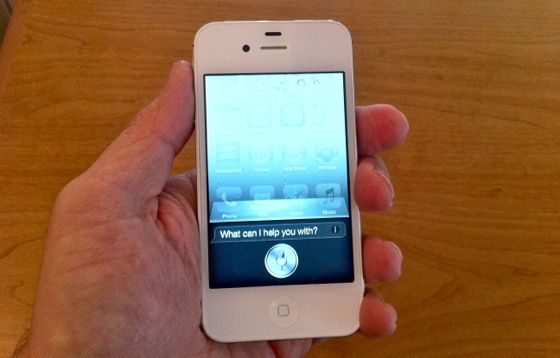



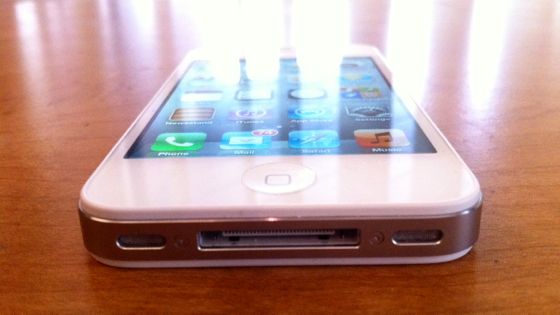
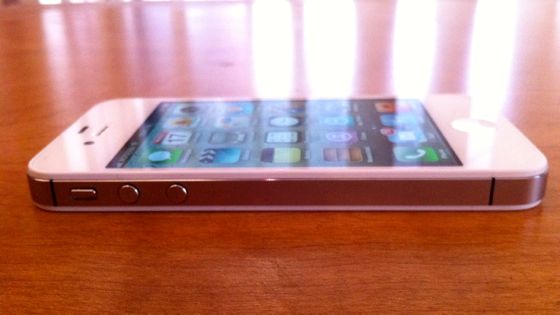

There are some small, subtle differences between iPhone 4S and iPhone 4. They're both 0.37 inches (9.3 mm) thin at 4.5 inches (115.2 mm) high and 2.31 inches (58.6 mm) wide but iPhone 4S is just a tad heavier at 4.9 ounces (140 grams). That's 0.1 ounces (3 grams) heavier than the iPhone 4 and iPhone 3GS.
Like the original AT&T/GSM iPhone 4, all iPhone 4S models have a microSIM tray. Like the later Verizon iPhone 4, the iPhone 4S has symmetrically aligned gaps in the external antenna array -- two on both sides.


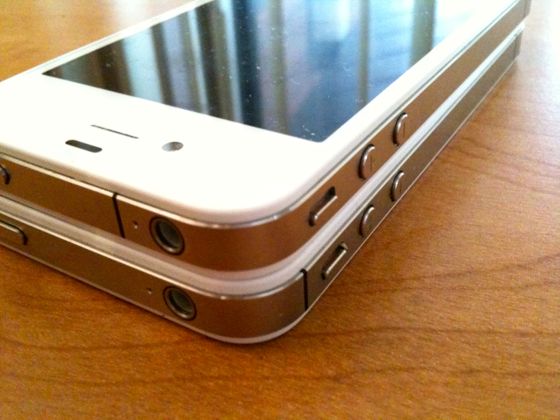
All the buttons and ports are where you'd expect them. 3.5mm headset, noise-canceling mic, sleep/wake button, microSIM card slot (even on CDMA models, see below), speaker, 30-pin dock connector, phone mic, volume up and down buttons, and the ring/silent switch. On the front, below the screen there's still a home button. Above the screen is the ear speaker and the VGA camera. On the back is the LED flash and the new 8 megapixel still, 1080p video camera.
Sensors also remain the same, with aGPS, a digital compass, ambient light, proximity, accelerometer, and gyroscope.
iMore offers spot-on advice and guidance from our team of experts, with decades of Apple device experience to lean on. Learn more with iMore!
Design evolution
While iPhone 4S is the 5th generation iPhone, it's only the 3rd major casing design in the product's history. Here it is compared to the original iPhone (2007) and the iPhone 3GS (2009).
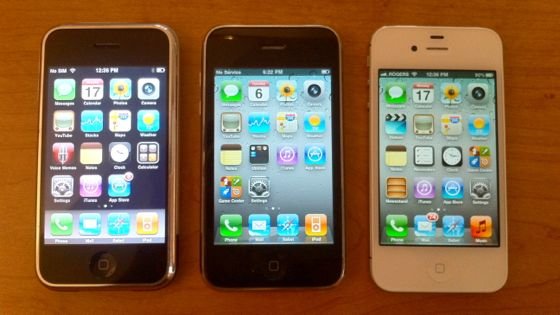
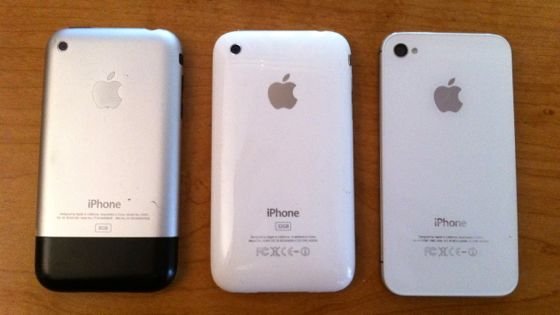
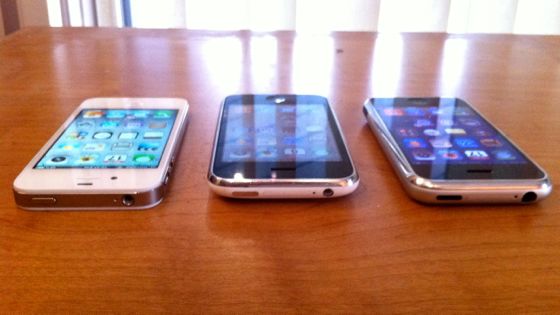


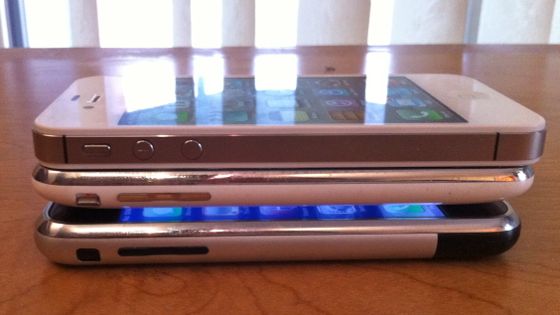
8 megapixel, 1080p camera

Apple chose not to improve the front-facing iPhone camera. Even though Macs have gone to FaceTime HD in 1280x720 (720p), iPhone 4S remains disappointingly 640x480 (VGA).
The rear-facing camera is another story entirely. It's been increased to 8 megapixels and is capable of recording 1920x1080 (1080p) video. Apple has also improved the backlight sensor, added an f/2.4, wide angle lens to capture as much light and picture as possible, and added an extra piece of glass into the assembly to increase sharpness. There's also an infrared filter to improve colors, face detection for better exposure and focus on portraits, and image stabilization to keep your videos from shaking.

We asked our app editor and resident photographer, Leanna Lofte to put it to the test.
- Complete iPhone 4S 8 megapixel camera review
- Complete iPhone 4S 1080p video review
- iPhone 4S photography examples
Overall, the iPhone 4S did a phenomenal job with landscapes, especially considering the broad range of lights and darks. With HDR (high dynamic range) enabled, the results were excellent. The f/2.4 lens lacks manual controls but handles motion far better than last year's iPhone 4.

Face detection works impressively well, even when the subject is moving around and the face partially obscured. The improved backlight sensor does far better in low-light situations, capturing shots that were impossible with iPhone 4.

Macro photography, however, proved to be more of a challenge. They look great if focus locks on, but often the iPhone 4S fails to lock focus. This might be an iOS 5 issue, and if so, hopefully Apple will fix it in a future update.
The 5x digital zoom and flash are serviceable if you really need them, but are really only useful when you have no other options.
For video, the iPhone 4S 1080p camera did a terrific job adjusting between shade and light, though under bright backlighting the video remained slightly underexposed. Image stabilization worked well for walking and panning but couldn't compensate for more extreme motion like running.
Low-light was better than iPhone 4 but wasn't great. There was visible grain, and image stabilization didn't work as well in low light conditions, but iPhone 4S' ability to compensate for color distortion was impressive and a huge improvement over iPhone 4. Again, macro video was incredibly sharp but iPhone 4S had trouble locking focus on very thin objects.
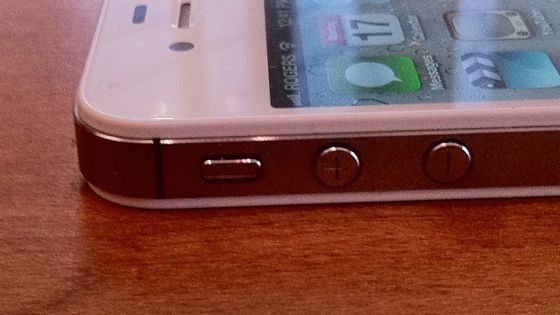
Apple has also focused on reducing the time it takes to get your photo or video. You can now double click the home button and tap a new Camera button right on the lock screen to go directly to the Camera app (bypassing Passcode Locks, so beware of pranks if you leave it unattended). You can now also take photos with the Volume Up button. The time it takes the shutter screen to "open" -- previously a area of frustration -- is also dramatically faster. And, according to Apple, a dedicated Image Signal Processing chip speeds up picture taking, with the first photo taking only 1.1 seconds and subsequent photos taking only 0.5 seconds.
Overall, for impromptu, casual photo and video taking, low end point-and-shoots have just been made redundant. Even for special occasions, vacations and other events, non-photographers and non-videographers can realistically rely on an iPhone 4S and be well served. Apple has done a terrific job here, giving iPhone 4S an incredible new eye.
Antenna and reception
If iPhone 4 had an achilles heel it was the external antenna band. At 5 bars, touching the right antenna junction could drop it down to 3. At 1 or 2 bars, it could literally became a network pause-play button. Yes, the mainstream media blew it completely out of proportion, and a case made it go away completely, but it was a flaw.
And Apple has addressed it by adding a second antenna and giving the iPhone 4S the ability to intelligently switch between the two to make sure reception is more reliable, more often. It also doubles the previous HSPA 7.2 speed to 14.4 Mbps.
- iPhone 4S intelligently switching antenna hands on

The new Qualcomm RTR8605 chipset is technically HSPA+, but doesn't include the much faster HSPA+ 21 or 42 Mbps data speeds. So data is faster if not dramatically so. In most areas those top speeds remain theoretical anyway, but it's a shame people who can get them, can't get them with iPhone 4S.
For CMDA users on Verizon and Sprint, none of this matters anyway, because iPhone 4S is still stuck on the 3 Mbps EV-DO rev A network, with all the limitations that come with it. These will likely only be overcome in 2012 or beyond, when LTE 4G (Long Term Evolution) chipsets are thin and energy efficient enough to meet Apple's requirements.
However, the new Qualcomm chipset does support dual-mode CDMA/GSM. That makes it a world-phone, and means if you travel outside the US you can roam on international GSM carriers. Verizon and Sprint may even unlock the GSM radio for you, if you're a good enough customer and ask nicely enough. Then you can use a local microSIM when you travel and avoid paying data roaming altogether.
Even so, you can't switch between Sprint and Verizon, or put in an AT&T SIM and have it just work. The carriers are still locking that down. (Time will tell if the Jailbreak community can set it free.)
Here are the supported bands:
- UMTS/HSPA at 850, 900, 1900, 2100 MHz
- GSM/EDGE at 850, 900, 1800, 1900 MHz
- CDMA/EV-DO Rev. A at 800, 1900 MHz
The AWS 1700 MHz band used by T-Mobile the USA, and Wind, Videotron, and others carriers in Canada, is still missing. That means T-Mobile is now the last major carrier in the US without an iPhone to offer, and it means that if you do run an unlocked iPhone 4S on T-Mobile US, it can still only run on the old, slow EDGE 2G network.
Wi-Fi has stayed the same as last year, with 802.11b/g/n Wi-Fi. The 802.11n also remains 2.4GHz only. The Bluetooth radio on the other hand has gotten a boost and now supports Bluetooth 4.0, which offers lower power consumption and lower latency.
Speaker and mics

Every year we hope the inventor of the iPod will put a decent mic and speaker system into the iPhone, and every year we get made fun of by BlackBerry, and more recently, Android Beats users.
While there haven't been any audio announcements by Apple, or stage demos by Apple executives similar to the kind afforded the optics, iPhone 4S does show real signs of improvement. The speaker is louder and clearer, making it easier to do hands-free calls.
The noise canceling mic does an excellent job in keeping both phone conversations and Siri voice commands functioning even in busy, noisy rooms.
And the vibration motor, which has reportedly been redone in a linear rather than rotational arrangement, is less annoying when it goes off, yet every bit as noticeable.
Audiophiles might still be waiting for Phil Schiller to give them the attention photographers got this year, but for average users the sound is an improvement.
Apple A5 System-on-a-chip
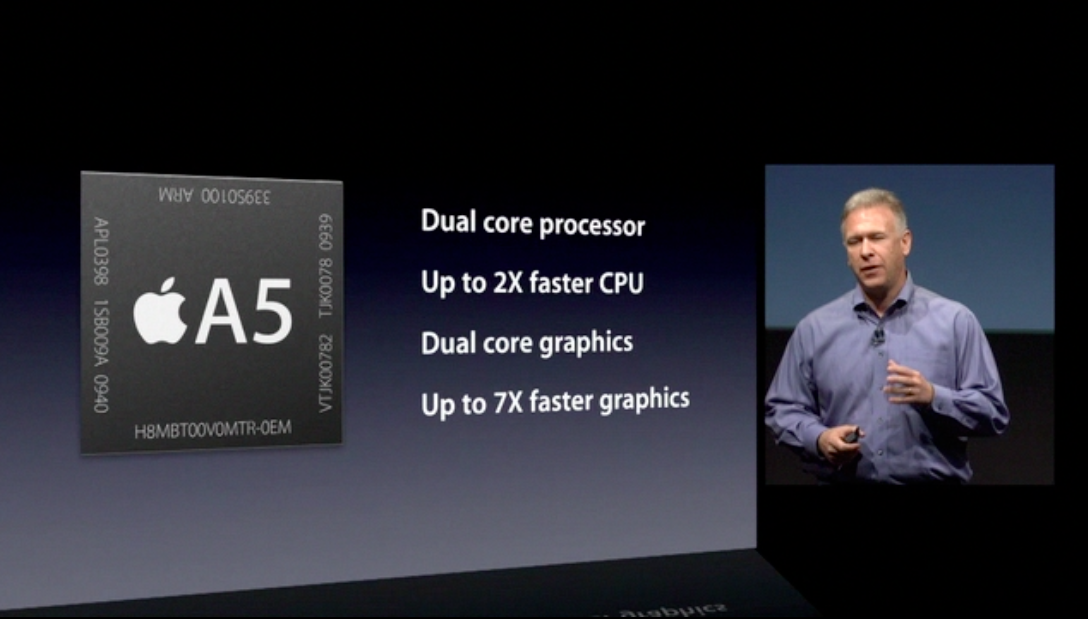
The iPhone 4S gets the dual core Apple A5 system-on-a-chip (SoC) that was first introduced last spring alongside the iPad 2. Reportedly based on ARM's Cortex A9 central processing unit with Imagination's PowerVR SGX 543MP2 graphics processing unit, Apple will only say it provides 2x the computing power and 7x the graphics power of iPhone 4. This lets it power everything from AirPlay Mirroring to the Siri virtual assistant.
Doing bigger things isn't the only point, however. Doing more smaller things faster makes a difference as well. Launching apps, rendering and scrolling through web pages, playing games -- all these things are palpably faster. Near-instant, in fact. You'll feel it right away, and if you ever go back to an older iPhone or smartphone, you'll miss it immediately.
Interestingly, Apple's stuck with the same 512MB of RAM for the A5. While competing phones are sporting 1GB these days, Apple seems to believe they don't need more RAM for better performance, or perhaps don't need the potential tradeoff in power consumption. Given the immediateness of its feel and its ability to keep a large amount of everything from web pages to apps in ready and available, it's hard to argue. Still, developers will keep pushing the silicon and it would have been interesting to see what 1GB would have let iOS 5 games achieve.
Battery power
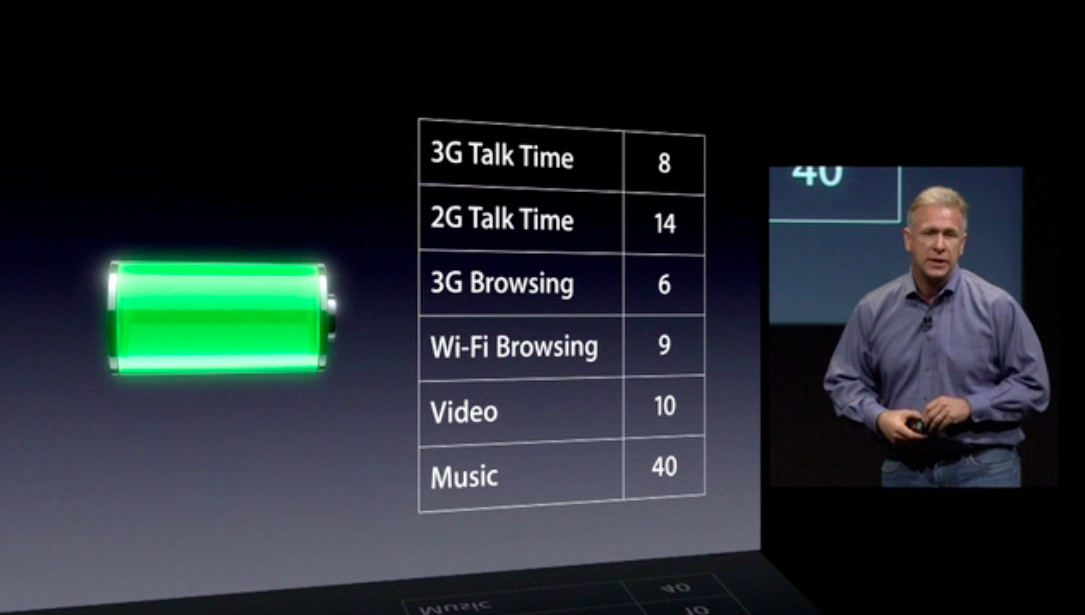
With the monstrous new Apple A5 SoC, and demanding new features like location-based Reminders and voice-crunching Siri, battery life should be a legitimate concern. Apple impressively claims very little change from the iPhone 4, though standby time seems to have taken a very large hit (down 33%).
- 3G talk time: 8 hours
- 2G talk time: 14 hours
- Web browsing: 6 hours
- Video watching: 10 hours
- Audio listening: 40 hours
In our tests it's hard to get a handle on. Reminders, Siri, and the other new features are so useful you end up using them more often, which leads to faster battery drain. If you stop using them (or turn them off in the Settings app), the battery seems just below iPhone 4 standards, but you lose out on all that great functionality.
If you charge frequently you can enjoy the best of both worlds, a phone doing what you need with power enough to do it when you need it. If you can't get to power, you'll have to moderate your usage.
We'll keep an eye on battery life going forward and update.
Accessory compatibility
While iPhone 4S is almost identical to iPhone 4, it's that almost that can get you. Depending on how well a manufacturer followed Apple's tolerance guidelines, most iPhone 4 cases should fit iPhone 4S, with Verizon iPhone 4 compatible cases likely providing the best fit. If in doubt, check into the specific case you want and ask about iPhone 4S compatibility. Here are some examples.
- TiPb iPhone 4S Accessory Store
- Amazon iPhone 4S Accessories
Sticker skins, cables, chargers, and headsets should all be compatible, and with better Bluetooth support, track information and other features should be better than ever before.
Likewise, the iPhone 4S gets not only the iPad 2's AirPlay Mirroring feature to get content to Apple TV and onto the big screen, but is compatible with the HDMI out Digital AV Adapter as well.
iPhone 4S Software
iPhone 4S ships with iOS 5, Apple's fifth generation mobile operating system and arguably the biggest update in the history of the platform. It includes features like unobtrusive Notifications, iMessage, Twitter integration, and a location aware Reminders app. Check out our massive write up on all the new features:
iCloud
iCloud isn't unique to iPhone 4S but it's launching at the same time and for the first time it makes online services and integral part of iOS. From eWorld to .Mac to MobileMe, Apple's previous Internet history has been one of high price and relatively low adoption. iCloud aims to change all that by not only being free, but far more functional than ever before.
We included iCloud in our iOS walkthrough, linked above, but here are the highlights:
- PC Free. iPhone 4S is the first iOS device you can take straight from the box and activate and setup with out ever plugging it in to a Mac or Windows PC. Backups and restores can likewise be done on-device and without a PC, and iCloud will also handle software updates over the air as they become available.
- Documents in the Cloud. For any app that supports it, like Apple's own iWork productivity suite of Numbers, Pages, and Keynote, any file created on one device -- iOS or Mac OS X -- will be effortlessly stored up on iCloud and pushed down to every other device.
- iTunes in the Cloud. Previously applicable only to App Store apps and games, in regions where Apple has secured the licensing, you can now also re-download previously purchased music, and in some areas, even TV shows to your iPhone 4S.
- Find my iPhone, Find my Friends. While Apple has been letting you track your iOS devices for a while, now you can also share location with your friends, either persistently or temporarily. Privacy controls are friend by friend, time restrictions down to the hour, and a kill switch is always on hand.
- Photo Stream keeps the last 30 days or 1,000 images available on all your iOS devices, and all your iCloud-enabled images backed up in iPhoto or Aperture on the Mac (but not both at the same time). Other than deleting the stream or logging out, however, there's no way to delete potentially awkward or embarrassing images -- or stop them from appearing as your Apple TV screen saver, for example. So shooter beware.
- Mail, contacts, calendars. Previously the largest part of MobileMe, Apple @me.com accounts can now be created on, or converted to, iCloud accounts. (Sadly, there's still no way to combine multiple accounts, for example MobileMe, iTunes, FaceTime, etc.)
- iTunes Match. Apple's music locker service, while announced, is not yet publicly available. When launched, it will scan your iTunes desktop library and, for $25 a year, make it available to you via iCloud -- in 256 bit ACC if it's part of iTunes massive collection.
All in all, iCloud seems to be a solid foundation for Apple. It's limited and has some flaws, like most first generation offerings. Hopefully it will grow to provide easier multi-device sync for things like game scores, and hopefully webOS-style Synergy services where multiple data types can be independently pulled, stored in separate silos, but presented in both single and combined views for users.


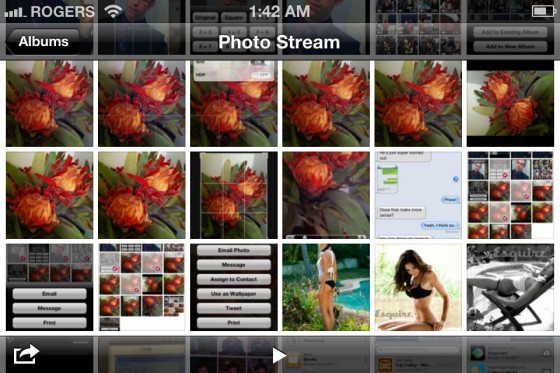
AirPlay Mirroring
AirPlay mirroring lets the iPhone 4S share it’s screen -- any screen on any app -- with the Apple TV over Wi-Fi. Since the Apple TV is designed to be plugged into an HDTV, this means you get your iPhone 4S content on the big screen.
While on the surface AirPlay mirroring might not seem like a major feature, it takes the personal, intimate experience of everything from gaming to FaceTime and makes it social. A keynote presentation projected in the boardroom or a group of friends playing a board game around the TV are just some of the obvious uses. Companies like Firemint are continuing to push the envelope as well, with concepts like multiple-device-to-Apple-TV Party Play. That's where iPhone 4S becomes a controller, and iOS starts to become a serious threat to traditional consoles in the casual space.
Siri
Siri is a natural language interface for iOS that combines powerful voice recognition (rumored to be powered by industry leader Nuance) and synthesized speech with an artificially intelligent query and response engine designed to become your “virtual assistant”. It replaces the previous Voice Control feature introduced with iOS 3 on the iPhone 3GS.
Siri is also the single biggest feature of the iPhone 4S. The speed is impressive, the camera a remarkable eye, but the voice and ear of Siri is what could define the next generation of computer interfaces. While that may sound hyperbolic, it's no more so than when Apple mainstreamed command line interfaces with the Apple II, mice and windows with the Mac, or multitouch with the original iPhone. All were derided as "toys" by those who lacked vision or merely disliked the idea of democratizing technology.
If Siri were simply a voice control and dictation system, like Android has had for a while, or like apps such as Vlingo or Nuance itself have previously made available on a variety of platforms, including iOS, that would be one thing. But Apple has imbued it with an almost Pixar-like humanity, a personality that while unmistakably artificial is also undeniably charming and engaging. That's probably why Apple, atypically, didn't rename Siri after purchasing the company behind it. Asking Siri a question creates a connection that would be far more difficult to achieve with a nameless "assistant" app.
Siri understands context. It understands relationships. It understands a smiley face. It can joke, even if canned. It makes you feel, for the first time, like you can have a conversation with your computer. You can ask Siri to tell your mother you're running late and it will address an iMessage. You can ask Siri to wake you up in 15 minutes and it will set an alarm. You can ask Siri to find you breakfast and it will search for local restaurants. You can ask Siri for the cast of the movie you're watching and it will query Wolfram Alpha. You can ask Siri her favorite color, and she'll tell you. She'll even present widgets, unique to her interface, if you prefer to tap than to reply.

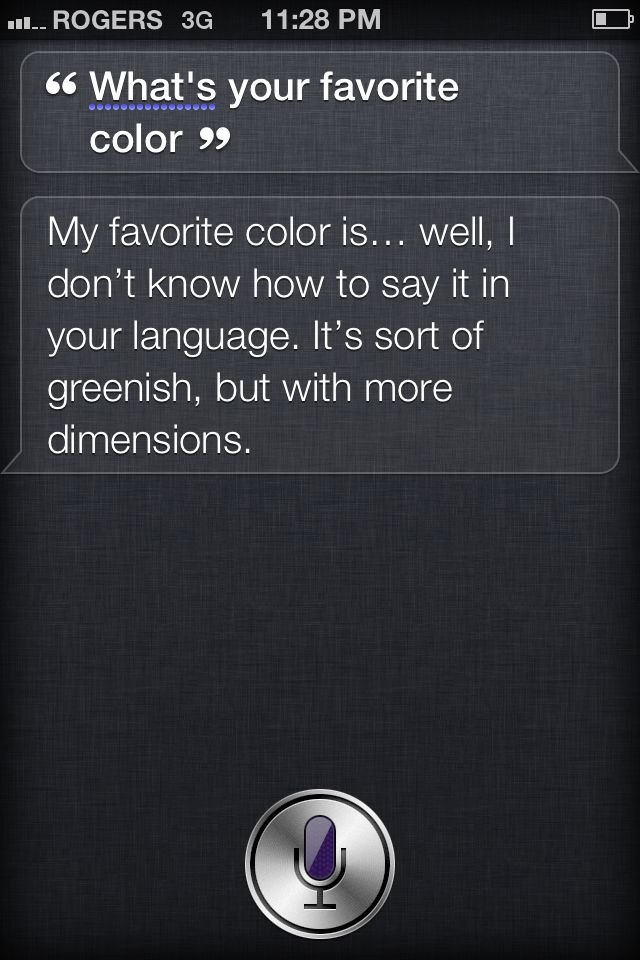

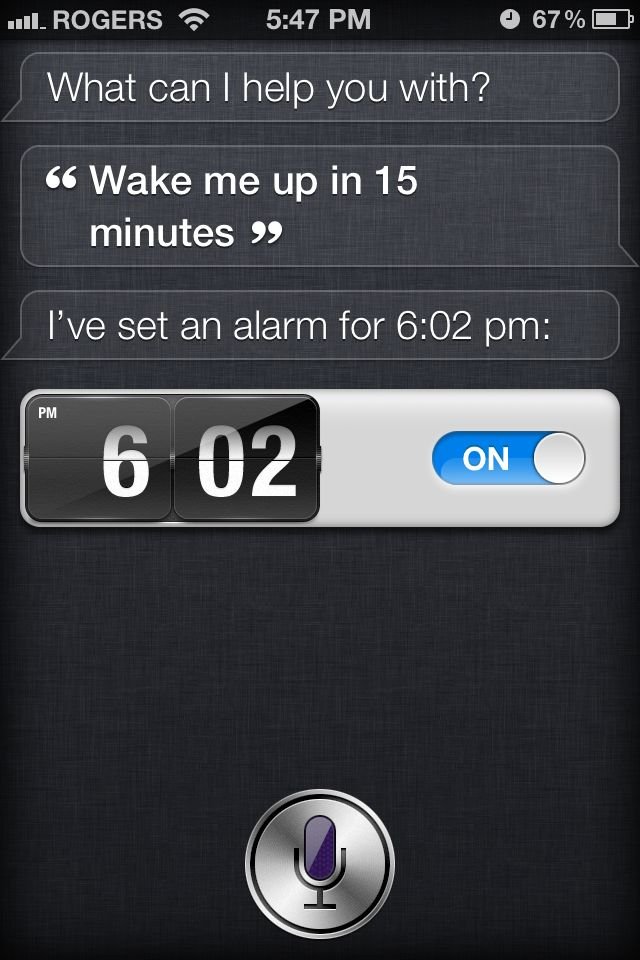
Siri is activated by pressing and holding down the Home button, or by bringing the iPhone 4S up and to your ear, like you would to make a phone call. You can activate the dictations feature alone by tapping the new microphone button on the system-wide keyboard.

Siri is, of course, by no means perfect. It's still in beta with limited language and even more limited location support. Siri's voice is female in the US and male in the UK and you can't alter that (unless you alter the region and your accent). Siri relies on servers that sometimes seem to be struggling to keep up with demand. There could be a customer insight play behind it. And, like humans or Pixar characters, it's fallible and frustrating at times. It makes mistakes, and it tries to "learn" going forward.
Also, Settings can't be toggle by Siri yet; there's no turn on/off Wi-Fi or Airplane mode. It can't launch apps to update your Facebook status or get you back into a game. It can't plug into the camera for Google Goggle's type searches, or into Apple's Faces technology to find a photo of your child. Siri is at her beginning, but it's a beginning that we've only ever seen in Star Trek. And that's exciting.
Apps and games
iPhone 4S is compatible with all the hundreds of thousands of iPhone apps contained in Apple's iTunes App Store. It's still not ideal -- there remain no upgrades, no demos, and Apple as single curator sets itself up as both bottleneck and -- though increasingly infrequently -- rejector of all apps on the platform.
With the power of the Apple A5 GPU, however, games have never looked better, and with the functionality of iCloud, apps have never been more useful. So while the app and game count remains the same, the potential has never been better.
iOS also remains the most web app-friendly platform in mobile, with an incredibly powerful HTML 5 rendering engine and fast Nitro JavaScript engine now available within Safari, embedded Web Views, and web apps saved to the Home Page.
Accessibility
Apple finished the iPhone 4 FaceTime video by showing a deaf person signing to a loved one. Apple finished the iPhone 4S Siri video by showing a blind person replying to a message through voice alone. They've also added custom vibration alerts, AssistiveTouch gestures, and other features. I'd be hard pressed to think of another company in consumer electronics doing as much to increase accessibility as Apple. They once again deserves a ton of praise for continuing to make this a priority.

Pricing and Availability
iPhone 4S is getting the widest, fastest distribution in Apple's mobile history. Starting October 14 in the US, Canada, Japan, France, Australia, and Germany, it will spread to over 70 regions by the end of 2011.
As always, Apple kept the pricing the same as previous years, offering more phone for the same money. This year, however, they've added a 64GB model for $399 on contract. And, while last year's iPhone 4 drops down to 8GB and $99 on contract, they've taken the unprecedented step of keeping the 2009 iPhone 3GS on the market, also at 8GB, but at $0 on contract. That's an iPhone at every price point from nothing to four hundred. No umbrella indeed.
Apple has also added Sprint as a carrier in the US, making it the 2nd CDMA carrier after Verizon.
- Sprint iPhone 4S review
They're also shipping the white model day and date.
Should you upgrade or cross-grade?

Overall, if you're thinking about upgrading from a feature phone or an iPhone 3GS or earlier model iPhone, do it. You'll be getting a spectacularly improved experience and feature set. If you're thinking about upgrading from an iPhone 4, then you need to make sure the major new features -- speed, camera, antenna, and/or Siri -- are compelling enough to warrant the cost. For most mainstream consumers, they won't be. For gadget lovers or geeks, you've likely already found a reason to justify it.
If you're thinking of crossing over from webOS, you should also do it. Now that Sprint is available and HP is floundering, iPhone 4S is a great choice. For BlackBerry lovers and Android aficionados, if you're not tired and ready for a change, wait and see what RIM's new QNX/BBX superphones and Google's Ice Cream Sandwich powered Galaxy Nexus-lead generation brings to the table.
Either way, here's some help in deciding which, if any, iPhone is for you:
- Should you get an iPhone 4S?
- Spec Wars: iPhone 4S vs. Samsung Galaxy S II vs. BlackBerry Bold 9900 vs. HTC Titan vs. Pre3
- iPhone 4S, iPhone 4, or iPhone 3GS: Which should you get?
- AT&T vs. Verizon vs. Sprint: Which iPhone 4S should you choose?
- Verizon and Sprint iPhone 4S and the limitations of CDMA
- 16GB, 32GB, or 64GB: Which iPhone 4S capacity should you get?
- Black or white: Which iPhone 4S color should you choose?
If you do decide to go with an iPhone 4S, here's some help getting started.
- iPhone 4S glossary
- How to setup your new iPhone 4S
- How to transfer your data over from your old iPhone to your new iPhone 4S
- How to transfer your data over from your old Android, BlackBerry, webOS or Windows Phone to your new iPhone
- iOS 5 for iPhone and iPad walkthrough
- Top 10 best tips and tricks for new iPhone owners
- Top 10 best apps for new iPhone owners
- iPhone Live! podcasts (with video!)
Conclusion
iPhone 4S may be evolutionary hardware, faster than iPhone 4, with a better camera and more resilient antenna, but iPhone 4 was a great phone and iPhone 4S is even greater. While the design remains one of the best in the industry, it also remains unchanged. If you like Apple's aesthetic, then you'll be very happy. If not -- if you would have preferred a larger screen or physical keyboard or a greater amount of standard ports -- than Apple has done nothing here to win you over, and likely won't ever on most of those counts.
In terms of software, almost everything about iOS 5 feels broader and better, and not only more functional, but more personal and more tactile as well. Apple has added more granular levels of control to things like Location Services and Data Storage, so you can keep private what you want to keep private and delete what you want to delete. They’ve also added more direct touch manipulation to the UI in Calendar and Mail, so the interactions are viscerally intuitive. At the same time they’ve increased the social, sharing aspects of iOS with services like AirPlay and apps like Find My Friends. It’s a clever balance. So is the interface, which Apple has kept as easy for novice users as it was in iOS 1 in 2007, and yet added ever greater layers of complexity for power users, including Fast App Switcher in 2010 and Notifications in 2011. For my sister, an iPhone makes calls, plays music, and takes photos. For me it can increasingly do almost anything.
Again, I can't help but come back to Steve Jobs, the man whose vision and singular will drove Apple to create the future of consumer electronics, device by device, app by app, culminating in the iPhone 4S announced just a day before his passing.
Like Jobs did, it stands at the juncture of technology and liberal arts, powerful and yet accessible, capable and yet beautiful, incremental new hardware brought to life by ambitious new software.
It's certainly not the device for everybody, but increasingly the iPhone is the device for most people.

Rene Ritchie is one of the most respected Apple analysts in the business, reaching a combined audience of over 40 million readers a month. His YouTube channel, Vector, has over 90 thousand subscribers and 14 million views and his podcasts, including Debug, have been downloaded over 20 million times. He also regularly co-hosts MacBreak Weekly for the TWiT network and co-hosted CES Live! and Talk Mobile. Based in Montreal, Rene is a former director of product marketing, web developer, and graphic designer. He's authored several books and appeared on numerous television and radio segments to discuss Apple and the technology industry. When not working, he likes to cook, grapple, and spend time with his friends and family.

